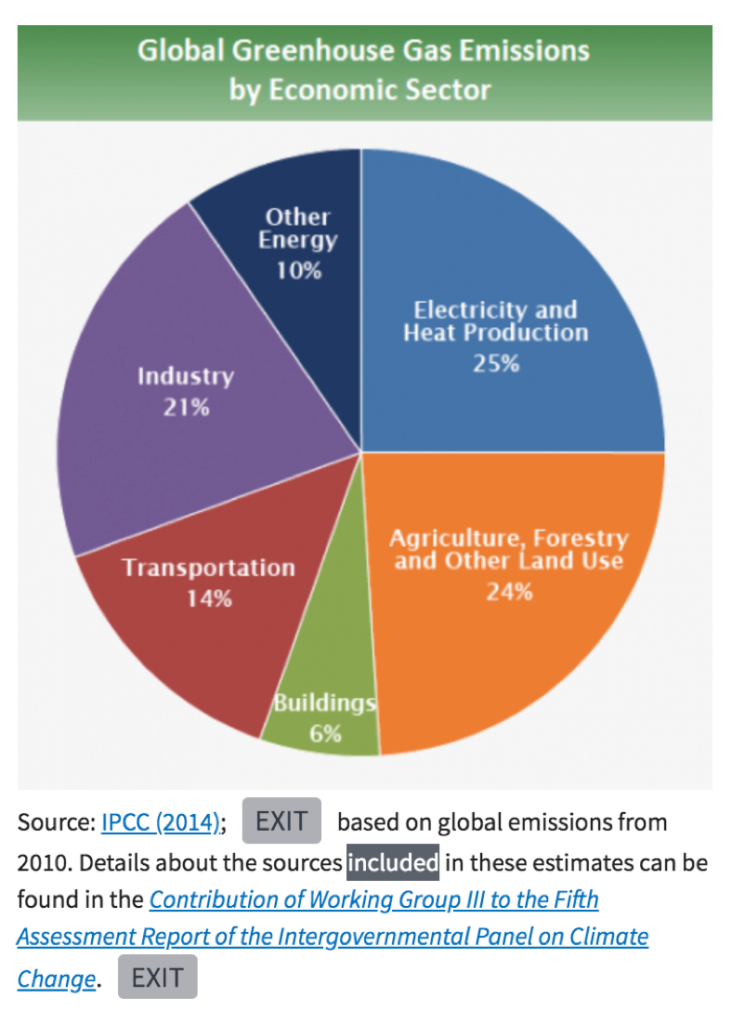
From carbon sink to carbon spigot

As recently as 10,000 years ago, virtually the entire habitable area of the planet consisted of forests and other wilderness. This acted as a giant carbon sink, the vegetation absorbing massive amounts of carbon dioxide.
Agriculture now covers 50% of the earth’s habitable land. And 77% of that agricultural land is for the raising of livestock – for grazing and growing animal feed crops.
Not all land currently used for agriculture was forest – but a huge proportion of it was. And much of that was cleared by burning it down, emitting huge quantities of greenhouse gases as carbon stored in trees and other vegetation was released into the atmosphere.
The razing of forests continues, with 50% of the world’s largest rainforest, the Amazon, predicted to be lost by 2050.1
Crops and grazing land absorb far less carbon from the atmosphere than forests and natural vegetation.2,3. They have a higher albedo, meaning they absorb a smaller fraction of the incoming solar radiation.4
Trees have a longer rooting depth and greater surface roughness length than crops, so removing them decreases both evapotranspiration and latent heat flux.5 6 Reduced canopy cover contributes further to lower evapotranspiration, and over large areas this can inhibit cloud formation.4
According to the Interparliamentary Panel on Climate Change, agriculture (as a whole), along with forestry and land use change, is responsible for 24% of greenhouse gas emissions.7

Agriculture’s share is much more than the transportation sector commonly believe to be the biggest culprit, and some scientists believe that when the loss of the carbon sink is fully accounted for, animal agriculture alone is ultimately responsible for 51% of emissions.
Aside from the carbon spigot opened up by burning them down, the process of clearing forests for animal agriculture sets off number of interlinked and mutually reinforcing changes that contribute to climate change.
REFERENCES
- 1.Magrin G, Garcia CG, Choque DC, Giménez CJ, Moreno AR, et al. Climate Change 2007: Impacts, Adaptation and Vulnerability. Cambridge University Press, Cambridge, UK; 2007:1-23. https://msuweb.montclair.edu/~lebelp/ipccclimatechange2007.pdf
- 2.Betts RA. Offset of the potential carbon sink from boreal forestation by decreases in surface albedo. Nature. Published online November 2000:187-190. doi:10.1038/35041545
- 3.Bala G, Caldeira K, Wickett M, et al. Combined climate and carbon-cycle effects of large-scale deforestation. Proceedings of the National Academy of Sciences. Published online April 9, 2007:6550-6555. doi:10.1073/pnas.0608998104
- 4.Longobardi P, Montenegro A, Beltrami H, Eby M. Deforestation Induced Climate Change: Effects of Spatial Scale. Añel JA, ed. PLoS ONE. Published online April 21, 2016:e0153357. doi:10.1371/journal.pone.0153357
- 5.Kleidon A, Fraedrich K, Heimann M. Climatic Change. Published online 2000:471-493. doi:10.1023/a:1005559518889
- 6.Bonan GB, Pollard D, Thompson SL. Effects of boreal forest vegetation on global climate. Nature. Published online October 1992:716-718. doi:10.1038/359716a0
- 7.Intergovernmental Panel on Climate C. AR5 Climate Change 2014. Mitigation of Climate Change. Published 2014. https://www.ipcc.ch/report/ar5/wg3/